Portrait of A Renaissance Man
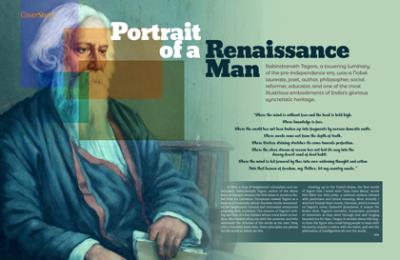
Rabindranath Tagore, a towering luminary of the pre-independence era, was a Nobel laureate, poet, author, philosopher, social reformer, educator, and one of the most illustrious embodiments of India’s glorious syncretistic heritage.
“Where the mind is without fear and the head is held high.
Where knowledge is free.
Where the world has not been broken up into fragments by narrow domestic walls.
Where words come out from the depth of truth.
Where tireless striving stretches its arms towards perfection.
Where the clear stream of reason has not lost its way into the
dreary desert sand of dead habit.
Where the mind is led forward by thee into ever-widening thought and action
Into that heaven of freedom, my Father, let my country awake.”
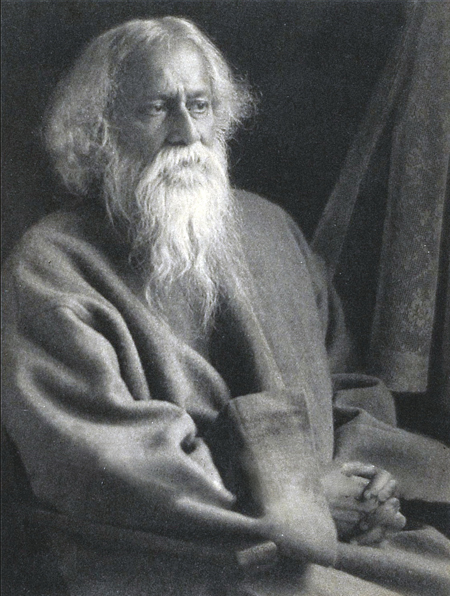
In 1912, a time of heightened colonialism and nationalism, Rabindranath Tagore, author of the above lines in Gitanjali, became the first Asian to receive a Nobel Prize for Literature. Europeans viewed Tagore as a beacon of humanity whose timeless words transcended the heightened colonial and nationalist sentiments plaguing their continent. The essence of Tagore’s writing was that of a free thinker whose mind knew no borders, who viewed all as one with the universe, and who embraced the richness of the world as his own. Now, over a hundred years later, these principles are pivotal for the world in which we live.
Growing up in the United States, the first words of Tagore that I heard were “Jana Gana Mana,” words that filled me with pride, a national anthem infused with patriotism and lyrical meaning. More recently, I watched Satyajit Ray’s movie, Charulata, which is based on Tagore’s novel, Nastanirh (translated, it means The Broken Nest). Tagore’s evocative, humanistic portrayal of characters as they went through love and longing haunted me for days. I began to wonder about this larger than life figure who could bring people to tears with his poetry, inspire a nation with his vision, and win the admiration of intelligentsia all over the world.
(Photo: Wikicommons).
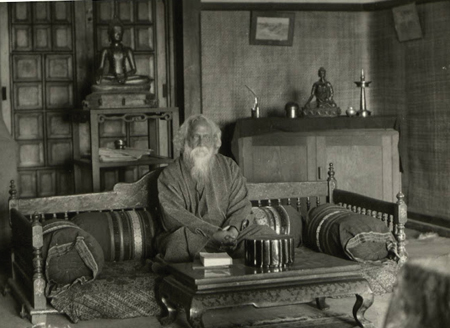
Tagore was at home whether in his own residence or traversing the globe, literally or culturally (Photo: www. oldindiaphotos.com, via Wikicommons).
An emblem of the Bengal Renaissance
Born on May 7, 1861, in Calcutta in British India, to one of the city’s leading families, Tagore’s principles of liberalism and unity were fostered by his upbringing. According to Adam Kirch’s The New Yorker article titled “Modern Magus,” “The Tagore family had long been at the forefront of India’s encounter with modernity and with England. Tagore’s father, Debandranath, was a philosopher and religious reformer who was active in Raja Ram Mohan Roy’s Brahmo Samaj Movement. In the midst of growing British influence, Brahmo Samaj was founded in 1828 to reform ‘backward’ customs such as the denunciation of polytheism and idol worship, and renunciation of the caste system.”
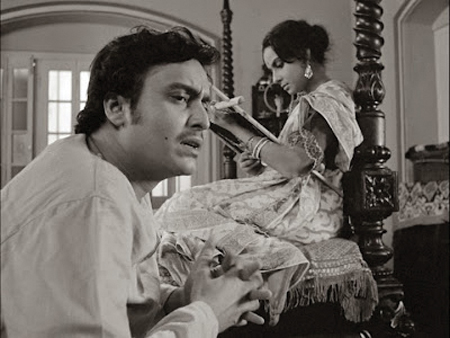
The convergence of the Western and Eastern cultures in the 18th and 19th century Bengali society was known as the Bengal Renaissance. This period witnessed a sociopolitical awakening in arts, literature, music, philosophy, religion, and science on par with secularist, humanist, and modern ideals of the day.
[Left] A still from Satyajit Ray’s Charulata, the acclaimed film based on Tagore’s novel.
Sam Hariharan is a professor of business at Babson College in Wellesley and a polymath. He told me, “Tagore was truly an emblem of the Bengal Renaissance’s richness. He knew enough about music, art, plays, and literature for all age groups. His capabilities on each of these were very strong. On top of all this, he was also a very original thinker on political issues like patriotism and nationalism.”
Although Tagore was opposed to blind nationalism, he harbored a very deep love for Bengal, his regional homeland, and the larger conception of India. This was particularly evident in his efforts to combat colonial acts of injustice towards his countrymen. In an attempt to rekindle the unified spirit of Bengal, Tagore wrote the patriotic song, “Amar Sona Bengal” (My Golden Bengal). The first ten lines of “Amar Shona Bengal” constitute Bangladesh’s national anthem which was adopted in 1971 during its liberation war with Pakistan.
Harmony with all existence
To gain a deeper understanding of Tagore’s beliefs, I spoke with Sugata Bose, a professor at Harvard and grandnephew of Netaji Subhas Chandra Bose. He commented, “Tagore was never in favor of a kind of cultural defense of India. In fact, he thought that India had a lot to teach the world, and so his universalism was laced with difference. Thus, I see him as espousing something which I describe as either different universalism or colorful cosmopolitanism. As part of this, you could love your own country, write in your own language, create beautiful literature and music, but at the same time, have a cosmopolitan attitude of mind.”
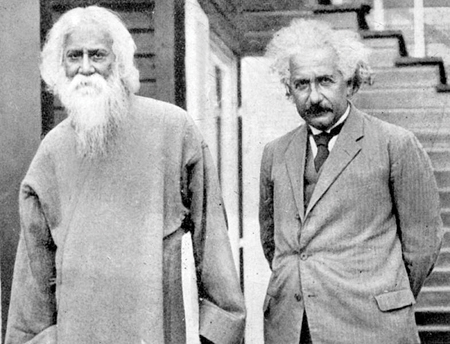
Tagore’s cosmopolitanism was reflected in his interactions both with Europeans and with the rest of Asia. Bose says, “While the intellectual exchange of Indians had previously mostly been restricted to Europeans, Tagore focused on other countries of Asia which had old thriving civilizations, but which, like India, had suffered under direct or indirect Western Imperial domination.”
[Right] Tagore was a citizen of the world who interacted with some of the most leading luminaries of his times. Seen here with Albert Einstein.
Recalling Tagore’s voyage to Southeast Asia, Bose said, “He regarded all of Southeast Asia’s literary and artistic creations as original, even when they were variations of Indian epics such as the Ramayana and the Mahabharata. He basically said that the Southeast Asian versions were originals, just like the Indian versions.”
Tagore’s attempt to spread cosmopolitanism among the Indian population began in 1901 when he founded an experimental school at Shantiniketan, approximately 100 miles north of Kolkata. In Tagore’s words, the guiding principle of the Shantiniketan School was that “the highest education is that which does not merely give us information but makes our life in harmony with all existence.” In the process, he sought to break down barriers by fostering connections across all castes, genders, and economic classes within the school’s student body.

With Chinese dignitaries. While the intellectual exchange of Indians had previously mostly been restricted to Europeans, Tagore also took interest in southeast Asian countries. (Photo: George Grantham Bain, Wikicommons).
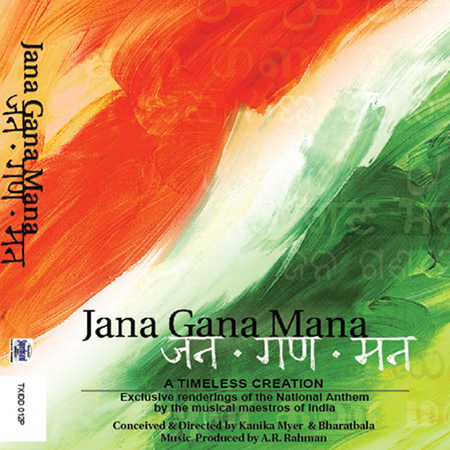 One of the hallmarks of Shantiniketan was open-air classrooms to liberate the mind from any sort of enclosure. The school offered a holistic curriculum that combined art, human values, and cultural interchange between East and West. Amartya Sen, Nobel Prize-winning economist and former Shantiniketan student, recalls “the ease with which discussions in the school could range from Indian traditional literature to contemporary Western thought, and to China, Japan, and elsewhere.” According to The United Nations Educational, Scientific and Cultural Organization (UNESCO)’s website, “to cultivate this interchange in the students of Shantiniketan, Tagore actively solicited the presence of visitors from all around the world.”
One of the hallmarks of Shantiniketan was open-air classrooms to liberate the mind from any sort of enclosure. The school offered a holistic curriculum that combined art, human values, and cultural interchange between East and West. Amartya Sen, Nobel Prize-winning economist and former Shantiniketan student, recalls “the ease with which discussions in the school could range from Indian traditional literature to contemporary Western thought, and to China, Japan, and elsewhere.” According to The United Nations Educational, Scientific and Cultural Organization (UNESCO)’s website, “to cultivate this interchange in the students of Shantiniketan, Tagore actively solicited the presence of visitors from all around the world.”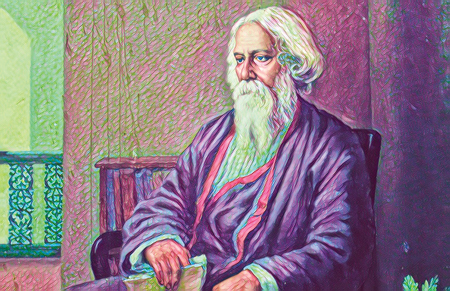
Sugata Bose commented that “Shantaniketan was a great experiment in Tagore’s time. Indian education at the time was infused with the colonial attitude that the British were superior to the Indians. Even when I studied history at Presidency College in the 1970s, we still had a colonial curriculum. There was not much of an opportunity to study the history of Asia, the Middle East, or anything of that sort. But in Tagore’s time, even under British rule, he had scholars coming from Japan, China, Southeast Asia, and Iran.”
He continued, “I think he subscribed to what might be described as an old-style patriotism. His witnessing of the First World War catastrophe convinced him that he did not want India to imitate the worst features of European nationalism and nation-states. In short, Tagore was always very clear that humanity stood above the nation.”
In 1905, British colonists partitioned Bengal Province into a Hindu West and a Muslim East. Satyajit Ray states in his documentary, Rabindranath Tagore, “This Partition fanned the flame of patriotism that had been smoldering in the minds of certain visionaries since the time of the Renaissance of Bengal.” In response, the Swadeshi Movement began and so, Indians stopped buying foreign goods and started relying on domestic production. The famous historian, Ramachandra Guha explains, “Tagore was critical of this development during the Swadeshi movement. He considered them xenophobic, chauvinistic.” He quoted Tagore as saying, “We must glory in the lamp anywhere in the world.”
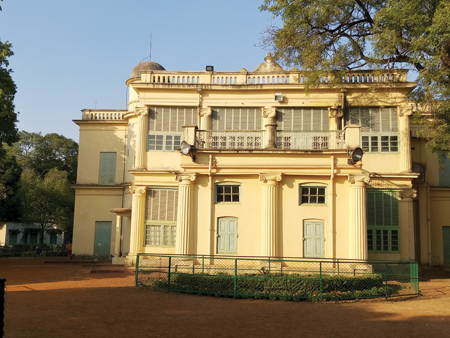
Shantiniketan, Tagore’s famous school (Photo: Wikicommons).
In the midst of the growing Hindu, Muslim, and anti-British agitation, Tagore strived to build bridges at the human level. He declared the day of Bengal partition on October 16, 1905, as a day of national mourning. According to an article in The Scroll, “In Bengal, the bond of Rakhi, also called Raksha Bandhan, once symbolized eternal protection between Hindus and Muslims. To signify the bond between Bengali Hindus and Muslims, Tagore wanted Hindus and Muslims to tie rakhis for one another, creating a lifelong bond of protection that no one could break.”
Tagore’s reaction to the 1919 Massacre of Jallianwala Bagh reflected his commitment to humanity above all else. In 1919, the British army opened fire on a peaceful crowd that had gathered in Amritsar’s Jallianwala Bagh to protest the Rowlatt Act, an event that indefinitely extended certain emergency measures. Ray explains in his documentary, “Following the attack, Tagore wrote a letter to the Viceroy. He ended with, ‘I, for my part, wish to stand shorn of all special distinctions by the side of my countrymen who for their so-called insignificance are liable to suffer degradation not fit for human beings.’ With this, he surrendered his knighthood.”
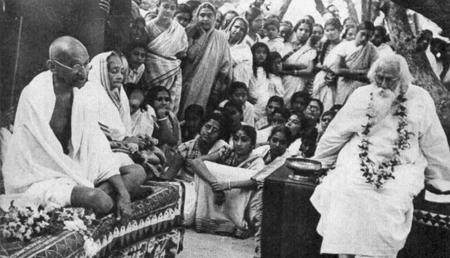
Tagore hosts Gandhi and his wife, Kasturba (Photo: Public Domain)
A national anthem steeped in plurality
The most prominent legacy of Tagore’s patriotism is “Jana Gana Mana,” the beautiful, all-encompassing, and evocative national anthem of India. The tune was born out of a song that Tagore wrote in 1911, “Bharoto Bhagyo Bidhata” (Dispenser of India’s Destiny), which was dedicated to the Supreme Divine God. In 1941, a Hindustani translation of the song, “Shubh Sukh Chain,” was adopted by Netaji Subhas Chandra Bose as the Indian National Army’s a them. Nine years later, in 1950, the first stanza became the national anthem of a newly independent India.
Through the national anthem, Tagore conveys the spirit of pluralism and the concept of unity in diversity which lies at the core of India’s cultural heritage. The first stanza is “Oh! The ruler of the minds of people, victory be to you, dispenser of the destiny of India! Punjab, Sindh, Gujarat, Maratha, Dravida, Orissa and Bengal, the Vindhyas, the Himalayas, the Jumna, and the Ganga and the oceans with foaming waves all around. Wake up listening to your auspicious name, ask for your auspicious blessings.”
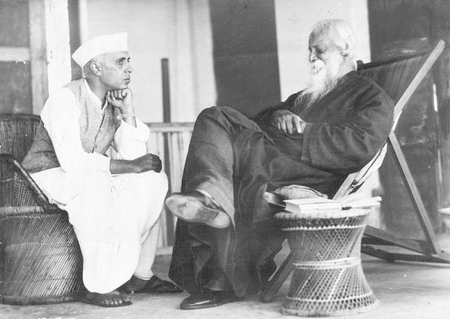
With Pandit Jawaharlal Nehru (Photo: Wikicommons)
The Nobel Prize for Gitanjali
Tagore wrote in a way that appealed to humanity in everyone regardless of religion, gender, and caste. He focused on the most fundamental themes of existence. Tagore’s collection of poems, Gitanjali, (Song Offering), written in 1910, is a collection of poems with devotion and love as the central themes. As Amartya Sen stated, “An ambiguity about religious experience is central to many of Tagore’s devotional poems and makes them appeal to readers irrespective of their beliefs.” Tagore’s inspiration for Gitanjali was largely drawn from the work of Bhakti poets, such as Kabir, who strived to bring religious reforms to all strata of society, making devotion itself a path towards salvation.
In 1913, Tagore received the Nobel Prize for his English translation of Gitanjali. This made him the first non-European to receive a Nobel Prize in literature. Adam Kirsch’s article in The New Yorker, “Modern Magnus” emphasizes how Gitanjali showed Europeans in the 1910s the “possibility that saintliness could still exist in the modern world. Tagore’s poems were sacred wisdom, an ancient Indian cure for a modern Western sickness.”

2232 songs celebrating Bengali culture, but also universalism
The part of Tagore’s work that is most deeply integrated into Bengali life is his collection of 2,232 songs, known as “Rabindra Sangeet.” Bose states, “Rabindra Sangeet was written over a long stretch beginning in the 1870s and going all the way up until his death in 1941. Tagore’s songs are very much a product of his experience with nature in Bengal and Bengali culture at one level. But at another level, his universalist aspirations are expressed in the most profound and in the most beautiful ways through his songs.”
Bose continues, “Rabindra Sangeet is divided into five genres—nature, patriotism, a general category with great variety, puja, and prem (devotion of love). Even though certain poems are categorized under ‘puja’ and certain others under ‘prem,’ it is difficult to distinguish because you never know for sure whether he is talking about divine or human love.”
[Right] With Sudhindra Bose, at University of Iowa in the U.S. (Photo: Wikicommons)
Hariharan explains, “Rabindra Sangeet has all the moods. Some songs are really sad while others are nostalgic. They are also meant to be hummable by people, as it is very easy to sing them. Today, you would be hard-pressed to find Bengali homes where at least some family members did not learn to play tabla and harmonium and sing Rabindra Sangeet.”
A song that particularly reflects Tagore’s broad thinking is “Purano Sei Diner Kotha” (“The Memories of the Good Old Days”). The lyrics translate as, “How can you forgo events of the good old days, dear? The glimpse of each other, the spirited chatting, are unforgettable. Come once more, my friend, come into my heart. We’ll talk about joys and sorrows to soothe the heart. We collected flowers at dawn, played, and swung a lot. Sang and played flute under the Bakul tree. Then happened the separation, alas we got diverged. When we’ve got a chance to unite once more, come into my heart.”
Hariharan states, “This song is based on the Scottish tune, ‘Auld Lang Syne.’ Today, Bengalis frequently sing this song when they reunite, recalling nostalgic memories together. This song illustrates Tagore’s openness to foreign influences, along with his message of unity, as people sing this song together rather than with just one performer.”
The reformist writer
In order to better understand the interconnectedness of Tagore’s philosophy and his works, I interviewed Dr. Pravina Cooper, a professor of comparative literature and film at California State University Long Beach. Cooper finds the novels, Nastanirh (The Broken Nest), and Ghare Baire (The Home and the World) as most reflective of Tagore’s reformist thinking.
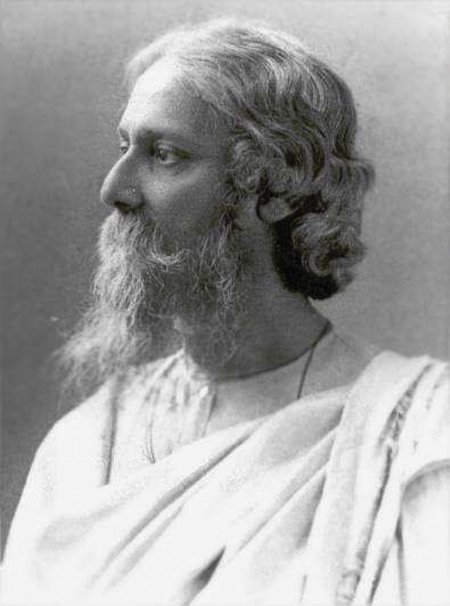
The Home and the World was set at the time of heightened nationalist movements and political debates which was reflected in the story itself. Cooper says, “The story revolved around Nikhil, an advocate of moderate, nonviolent political reform, and Sondip, who yearned for a revolutionary violent overthrow of the British. Bimala, Nikhil’s wife, was caught between these two polar opposite political paths.” Cooper says, “Bimala can be a metaphor for India, as she is initially attracted to Sondip, but then goes back to Nikhil politically. The story ends with Nikhil as the real solution, not Sondip. Reform means you take what you have to improve society and your own tradition.”
Broken Nest mostly illustrates feminist values. Bhupati is an old-fashioned, workaholic husband who is oblivious to his wife Charu’s feelings. In Bhupati’s absence, Charu falls in love with Amal, her brother-in-law, who is charming, and more emotionally present than Bhupati. Cooper states, “Charu is very emotionally starved, so she goes towards Amal. However, Amal is a flash in the pan, he comes and vanishes. He is a less stable option. In the end, Charu goes back to Bhupati who understands how and why she fell in love with Amal. Bhupati does not punish her and instead stretches his hand to her. That is part of being a reformer. He could have punished her and thrown her out. Any stability is part of reform.”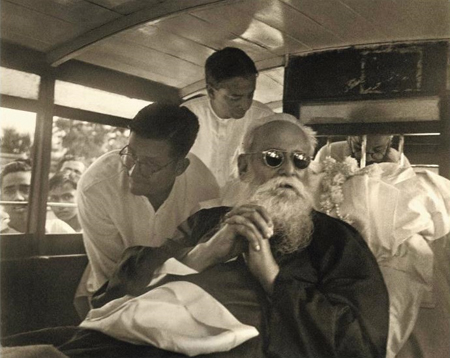
Cooper summarized, “Tagore became this global liberal because he absorbed everything. His inclusiveness is what helped give us what we call Indian modernity, tradition mingled with modern elements.” Bose adds that Tagore “showed how it was possible to reach the heights of creativity, even when your own country was under foreign domination.”
[Right] The last photo on record of Tagore (Wikicommons)
Tagore’s philosophy showed me that an exclusive focus on parochial identity can come at the cost of embracing the world’s social and cultural richness. It deepened my understanding of my own identity as an Indian-American and helped me think of my aspirations: embrace everyone’s humanity without searching for labels. It is humanity that unites us all.
William Butler Yeats, the famed Irish poet, who championed Tagore to the Nobel committee, wrote, “We fight and make money and fill our heads with politics—all dull things in the doing—while Mr. Tagore, like the Indian civilization itself, has been content to discover the soul and surrender himself to its spontaneity.”
Nikhil Misra-Bhambri is a freelance journalist living in Los Angeles, California. He graduated in history from the University of Southern California (USC) and writes about relationships between cultures, cuisine, music, and history.
Enjoyed reading Khabar magazine? Subscribe to Khabar and get a full digital copy of this Indian-American community magazine.
blog comments powered by Disqus










